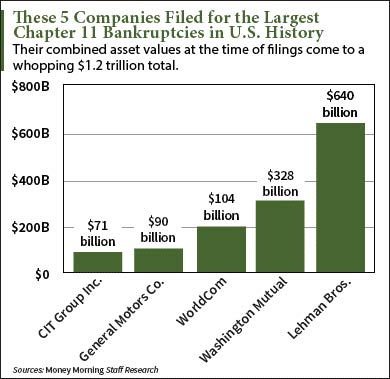Washington MutualFounded1889WebsiteWashington Mutual (WaMu) has the dubious distinction of being the biggest to fail in U.S. When it collapsed in September of 2008, its $307 billion in assets eclipsed the $40 billion of, which failed in 1984, and the $32 billion of, which the government seized in July of 2008.Perhaps key to the giant banking entity's downfall was that under chairman and chief executive officer the company began buying up other banks and home-loan operations in the 1990s. WaMu became the nation’s top bank in servicing.When the downturn in the housing market began to occur, losses started piling up for the business at an alarming pace.

The strategy that had allowed for the bank’s phenomenal expansion — focusing on lower-income borrowers — was now resulting in devastating losses.Killinger gave up his job as chairman in June 2008 and on Sept. 8, 2008, was forced to retire as chief executive officer by the bank’s board., who had been chairman of the mortgage broker, replaced him on Sept. 16, 2008.Fishman had said that he intended to keep WaMu independent. As rumors about the company's financial problems circulated, Fishman tried to reassure investors and depositors by releasing more details about the company's financial health.Eventually though, Fishman asked, hired by WaMu earlier in the year as it sought additional, to put the thrift up for sale.acquired the banking of WaMu on Sept. 25, 2008 after the troubled thrift was seized by federal regulators, marking the biggest bank failure in the nation's history and another stunning twist in the U.S.
Under the deal, JPMorgan Chase would acquire all the banking operations of WaMu, including $307 billion in and $188 billion in.Funds that may have lost money as WaMu imploded included ’s which added around 12 million WaMu shares in the second quarter of 2008;, a Chicago-based, which had 7.3 million WaMu shares as of June 30; which had 2 million shares; and which had 10.5 million.WaMu shares — which a year ago fetched $35.66 — fell by more than half to $4.93 the week the failure was announced. Contents.HistoryThe bank was created in 1889 to help the city of Seattle rebuild its downtown after a devastating fire.Key events in the WaMu's lifespan were as follows:1889: is founded after fire destroys much of Seattle's core. The following year it makes the first monthly installment on the Pacific Coast, $700 to build a house in Ballard.1917: Reconstituted as, it has more than 16,000 -owners when the U.S. Enters World War I. During the war, Washington Mutual's assets rise 68 percent.1930: Washington Mutual makes the first of many acquisitions, rescuing from financial distress as the deepens.1970s: The company pioneers the first shared cash machine network in the nation,.1980s: Washington Mutual buys firm of Spokane. It converts to ownership, with starting to trade on March 11, 1983.Early 1990s: Kerry Killinger becomes CEO in April 1990 and chairman of the board the next January.
From 1990 to 1996, WaMu acquired 16 smaller banks in Washington, Oregon, Utah and California.1997-98: Washington Mutual buys and for a combined $13.6 billion, becoming a West Coast power with their strong California presence.1999: The company buys, which writes mortgages for people with less-than-stellar credit. Killinger calls it 'an important extension of Washington Mutual's core strategy to be one of the nation's leading consumer-oriented financial-services.' 2001: Acquisition of Dime Bancorp gives Washington Mutual a big New York presence. The company also buys, becoming for a time the nation's No. Bluetooth usb horus issc driver. 1 mortgage originator.2005: Washington Mutual buys credit-card issuer.2006: Washington Mutual eliminates more than 10,000 jobs to cut costs as mortgage originations slow.April 2007: WaMu reports a 20 percent decline in first-quarter profit, beginning a year of increasing difficulties. Killinger warns of 'unprecedented deterioration' in the subprime-mortgage market but predicts WaMu's home-lending unit will become profitable again by year's end.December 2007: WaMu hit an 11-year low after it cuts its dividend by 73 percent. The company says it's cooperating with an SEC inquiry stemming from allegations by N.Y.

Attorney General that it made loans based on improperly inflated home appraisals.Jan. 17, 2008: WaMu posts its first annual loss since Ronald Reagan was president, due to fourth-quarter red ink of $1.87 billion.April 8, 2008: An investor group led by David Bonderman's TPG pumps $7.2 billion into WaMu, getting just over 50 percent of the company at $8.75 a share. WaMu says it will close its approximately 186 remaining stand-alone home-loan offices, laying off 2,600 to 3,000 workers.June 2, 2008: Kerry Killinger is removed as WaMu chairman after 17 years, replaced by board member. Killinger remains CEO.June 17, 2008: WaMu says it is cutting 1,200 more jobs, including 260 at its downtown Seattle headquarters.July 14, 2008: Investors worried about the financial sector's weakness send WaMu shares down 35 percent to $3.23, a level not seen since February 1991.July 22, 2008: WaMu posts a $3.3 billion loss for the second quarter.Sept.
7, 2008: CEO Killinger is forced out, replaced by Alan Fishman, former chief executive of, which was sold two years ago to Sovereign Bancorp. Government takes control of mortgage giants and.Sept. 14-19, 2008: Lehman Brothers files for bankruptcy protection, Merrill Lynch is rescued by Bank of America and the federal government takes over insurer American International Group. WaMu's shares sink to $2.01.Sept. 25, 2008: After massive withdrawals by depositors, regulators seize WaMu and arrange a sale of its and to J.P. Morgan.Products and Services Key People References. The New York Times.
Washington Mutual Files Bankruptcy Online
Swamp Politics. Crain's Chicago Business.
Posts
- Europolis Game
- Wbfs Games S
- Settlers Iii Mac Download
- Magic Bullets Savoy Rapidshare
- Ministry Of Sound Anthems Hip Hop Rapidshare
- Yamatake Sdc31 User Manual
- Joan Jett The Hit List Rapidshare Premium
- Asus Atk Driver Windows 8
- Painkiller Booh Patch Ver.1.65
- Maximum Roadkill Pirate
- Areas Cerebrales Pdf
- Yu Gi Oh Gx Game
- Diagrama De Secuencias Uml Pdf
- Bob Admit Card Of Ssc Cgl 2013
- Program S2 Komunikasi Ui
- Philips Ga30006 Driver Software
- Ms Dos Iso Image
- Best Of Eko
- Malayalam Font
- Becca Tobacco Foundation
- Download Software Freemake.video.downloader 3.7.1 Offline Downloader
- Free Download Komik Dragon Voice